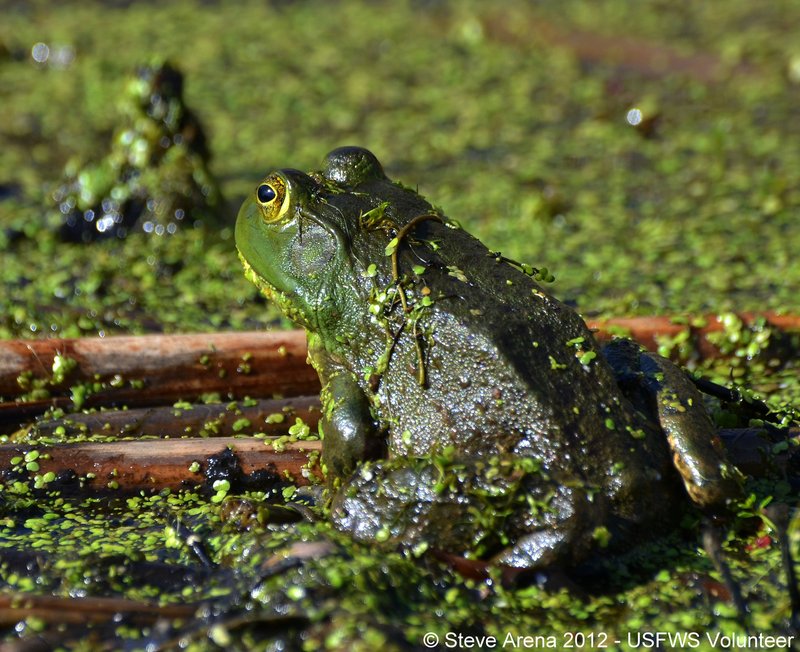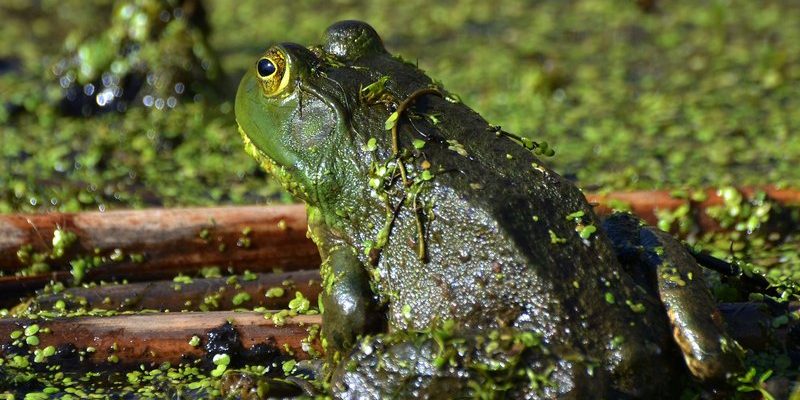
Imagine strolling by a peaceful pond on a warm summer evening. As you approach, you hear a deep, resonating croak that seems to reverberate through the air. That sound likely belongs to the bullfrog, a fascinating amphibian known for its distinct call and impressive size. Native to North America, these creatures thrive in wetlands and can often be found lounging on lily pads or lurking in the muddy shallows.
Bullfrogs, scientifically known as Lithobates catesbeianus, are not just average frogs; they have a variety of characteristics that set them apart. They can grow up to eight inches long, making them one of the largest frogs in the continent. With their vibrant green and yellow coloring, they can easily blend into their marshy environment, which makes them both hunters and the hunted. In this article, we’ll dive into the world of bullfrogs to explore their unique habits, habitats, and more.
Physical Characteristics
The bullfrog is hard to miss with its impressive size and bold features. On average, adult bullfrogs measure about four to six inches in length, but some can grow to be even larger—up to eight inches from snout to tail! Their skin is typically a vibrant green, which can sometimes appear brownish, allowing them to sit camouflaged among plants. Perhaps most striking are their large, round eardrums, which can be seen behind their eyes. These eardrums are crucial for their iconic croaking sounds that can be heard from miles away during mating season.
Another interesting aspect of their physical appearance is their long, powerful legs. These muscular limbs allow bullfrogs to leap great distances, up to ten times their body length. This ability helps them evade predators and swiftly catch prey. Their webbed feet also help them navigate water with ease. You might think of them as the “athletes” of the amphibian world, equipped for both swimming and jumping.
Habitat and Distribution
Bullfrogs are typically found in shallow waters of ponds, lakes, marshes, and slow-moving rivers. They enjoy habitats where there are plenty of aquatic plants, as these not only provide cover from predators but also serve as places to lay their eggs. Typically, they prefer warm, still waters that are rich in food sources. This is why you’ll often hear their distinctive calls echoing in the evenings or during rainy nights when they are most active.
In terms of distribution, bullfrogs are widely spread across North America, from southern Canada down to northern Mexico. They’ve even been introduced to other parts of the world, where they sometimes become invasive species. Their adaptability to various environments, along with their hearty diet, makes them a resilient frog species. However, this adaptability can sometimes work against them, as they compete with local species for resources in areas they invade.
Diet and Feeding Habits
Bullfrogs are opportunistic feeders, which means they eat whatever they can catch. Their diet primarily consists of insects, but they won’t stop there. They’ve been known to dine on small fish, other frogs, and even small mammals or birds if the opportunity arises. This varied diet makes them an essential part of their ecosystem, helping control the population of insects and other small creatures.
When it comes to hunting, bullfrogs have a few tricks up their sleeves. They are ambush predators, which means they prefer to sit still and wait for prey to come close before striking. With a quick flick of their long, sticky tongues, they can snatch unsuspecting insects right out of the air. This method of hunting is not only efficient but also quite fascinating to watch.
Breeding and Lifespan
You might be wondering about the life cycle of a bullfrog. These amphibians begin their lives as eggs laid in water, usually between late spring and early summer. A single female can lay thousands of eggs, all of which hatch into tadpoles within a week or two. These tadpoles are herbivorous and will gradually develop into the adult form over several months. It’s a fascinating transformation, much like a caterpillar becoming a butterfly.
After they metamorphose into frogs, bullfrogs become sexually mature within a year or two. During breeding season, males are particularly vocal, using their croaks to attract females. These calls can be quite loud, sometimes resembling a cow’s moo, hence the name “bullfrog.” In the wild, bullfrogs can live up to 7 to 10 years, although some have been known to reach 16 years in captivity. Their lifespan can be affected by environmental factors, predators, and availability of resources.
Behavior and Social Structure
Bullfrogs are generally solitary animals but can often be seen congregating in large groups during mating season. This is when their vocal calls fill the air as males compete to attract females. Each male has a unique call, and you might find it intriguing how these sounds echo in the warm night air, creating a natural symphony.
When they’re not busy calling out during mating season, bullfrogs spend most of their time resting on vegetation or rocks near the water. They are primarily nocturnal, meaning they come alive at night when they hunt for food. Their keen eyesight and excellent hearing help them detect movement in the dark, allowing them to make a successful catch.
Conservation Status
In terms of conservation, bullfrogs are currently not considered endangered. However, their populations can be affected by habitat destruction, pollution, and climate change. As human activities encroach on wetlands, bullfrogs lose crucial breeding and feeding grounds. Furthermore, in areas where they have been introduced, they can outcompete local frog species, leading to declines in native populations.
Conservation efforts focus on protecting their natural habitats and ensuring water quality remains high. Wetland restoration programs are vital to maintaining a healthy ecosystem where bullfrogs and other species can thrive. Understanding the role of bullfrogs in their ecosystems is essential for maintaining biodiversity and ecological balance.
Interesting Facts about Bullfrogs
| Common Name: | Bullfrog |
| Scientific Name: | Lithobates catesbeianus |
| Size: | 4 to 8 inches |
| Weight: | 1 to 1.5 pounds |
| Diet: | Insects, small fish, and other amphibians |
| Lifespan: | 7 to 10 years in the wild |
| Habitat: | Ponds, marshes, and lakes |
FAQ
How can I identify a bullfrog from other frogs?
Identifying a bullfrog is relatively straightforward once you know what to look for. They are one of the largest frog species in North America, typically measuring between four to eight inches in length. Look for their distinctive green or brown skin, large eardrums behind the eyes, and powerful legs. Their croaking sound is also a great indicator; bullfrogs are known for their deep, resonant calls.
Where do bullfrogs lay their eggs?
Bullfrogs prefer to lay their eggs in shallow, warm waters, typically in ponds or marshes. A female bullfrog can lay thousands of eggs, which are usually deposited in clusters. These eggs hatch into tadpoles within a week or two, usually during late spring or early summer. The presence of aquatic vegetation is essential for providing cover for the eggs and the developing tadpoles.
What do bullfrogs eat?
Bullfrogs are opportunistic feeders, meaning their diet can vary widely. They primarily eat insects, but are not shy about going after small fish, other frogs, and even small mammals or birds. They are ambush predators, using their long tongues to quickly capture prey that comes too close. Their diverse diet makes them essential players in their ecosystems, helping control insect populations.
Are bullfrogs harmful to other wildlife?
While bullfrogs are not inherently harmful, their introduction to non-native habitats can lead to competition with local amphibian species. They can outcompete smaller frogs for food and breeding space, sometimes causing declines in native populations. In places where they have been introduced, they have become invasive, which poses a risk to local ecosystems.
How do bullfrogs survive winter?
During the winter, bullfrogs enter a state of brumation, similar to hibernation but not as deep. They become less active and may bury themselves in mud or search for sheltered areas near water sources. When temperatures rise in the spring, they emerge to resume their activities, including mating and feeding.
Can bullfrogs be kept as pets?
Yes, bullfrogs can be kept as pets, but they require specific care to thrive. A suitable habitat, including water, plants, and space to jump, is essential. Maintaining proper temperature, humidity, and diet will help ensure their health. However, owning a bullfrog also comes with responsibilities, including recognizing their needs and the potential impact on local ecosystems if they are released outside.
How long do bullfrogs live?
Bullfrogs can live quite a long time for amphibians. In the wild, they typically live 7 to 10 years, though some have been known to reach up to 16 years in captivity. Lifespan can be influenced by many factors, including environmental conditions, availability of food, and exposure to predators.
What is the bullfrog’s role in the ecosystem?
Bullfrogs play a vital role in their ecosystems as both predator and prey. They help control insect populations, which can benefit agriculture and natural systems. At the same time, they serve as a food source for various animals, including birds, snakes, and small mammals. Their presence contributes to biodiversity and helps maintain ecological balance.
Are bullfrogs endangered?
Currently, bullfrogs are not considered endangered. However, they face threats from habitat destruction, pollution, and climate change. Conservation efforts are essential to protect their habitats and ensure they can continue to thrive, especially in areas where they have been introduced and disrupt local ecosystems.
Can bullfrogs jump over fences?
Bullfrogs are impressive jumpers, capable of leaping up to ten times their body length. While they might not “jump over fences” in the traditional sense, they can certainly clear significant obstacles. If you’re thinking about keeping them in an enclosure, it’s best to ensure it’s high enough to prevent escape if they feel inclined to hop around!
How loud are bullfrogs?
Bullfrogs are known for their loud, resonating calls, especially during mating season. Their croaks can be heard from over a mile away! This sound is not only distinctive but can also vary among individual males, with each having unique vocalizations. So yes, if you’re near a pond in the evening, you might find yourself serenaded by the “bullfrog orchestra.”

